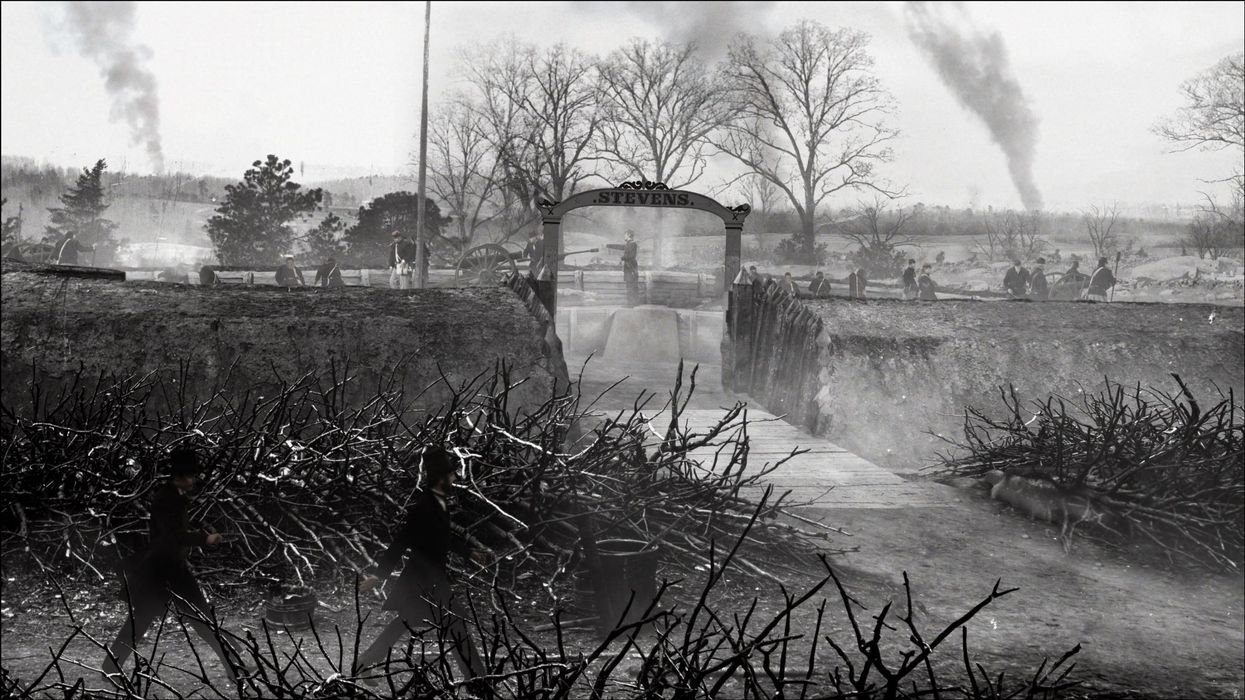Civil War Film 'Saving Lincoln' Uses Actual Historical Photographs as Background VFX Plates

Ever seen a period film shot entirely with backgrounds made from historical photographs? No? Well, me neither, but Salvador Litvak has done just that for his film Saving Lincoln, and he's now looking to distribute this independent film with the help of Kickstarter. He's taken to the crowdfunding website to sell the movie and help take it on a theatrical release, and today we've got a post explaining exactly what's so special about Saving Lincoln and the process his team went through to accomplish this monumental task.
This is a guest post from Salvador Litvak.
Here is the trailer for the film:
Saving Lincoln is the true story of Abraham Lincoln and his closest friend & bodyguard, Ward Hill Lamon. The film features virtual sets created from actual Civil War photographs, through a process I invented called CineCollage. Because Steven Spielberg announced his Lincoln movie just after my wife, Nina Davidovich, and I finished writing ours, I had to find an independent way to tell our epic story. During our research, I spent countless hours in the online Prints and Photographs division of the Library of Congress, where I found a trove of wet-collodion, glass-plate photographs. Thanks to the LOC, these images have been digitized at extremely high resolution.
I imagined our scenes taking place in these locations, and after watching films like 300, Sin City, and the lesser known French film, The Lady and The Duke, I realized we could use modern technology to transform those vintage black & white photographs into 3D environments. Of course, the process ended up being MUCH more challenging than I anticipated, but I was blessed with an amazingly creative team that was both talented and nimble. Among them are VFX Producer Kristian Hansen, and VFX Supervisor-Designers Daniel Land, Catherine Tate, Ryan Bauer, and Gabe Hall. And I can't leave out our Editor/Slap-Comper Extraordinaire, Josh Noyes. We did a lot of testing during our pre-viz stage, and developed the following workflow:
- Boil down each scene to its essential EMOTIONAL elements and make sure those are communicated visually. This is both a writing and directing task, and one which we kept circling back upon. Eventually we made the film in 730 shots, a very low number for a narrative feature, but a very high number for an indie film requiring VFX process for every shot.
- Find a photograph or "plate" that can become the location for the scene - if none exists, find related plates and harvest photographic material that can be assembled into a 3D set;
- Storyboard the scene so all departments are on the same page;
- Shoot the scene against a green screen, using on-set rough compositing to match camera height, distance and lensing with the historic photographs;
- Create a package of the above materials and farm out to our compositors, based primarily in San Francisco, New Orleans, Detroit, and Europe;
- Conduct twice daily group meetings via google hangout or gotomeeting to keep everyone on the same page, while learning from each others mistakes and aha-moments;
- Go back and forth with our digital artists until every shot gets finaled: and
- Assemble all shots, color-correct and smooth out the bumps.
Post-production was pretty massive, but we got it done in less than a year, which rocks for an all-VFX film made for under $1 million.
Completing the film is an achievement I'm immensely proud of, but it's only half the battle. We knew we'd have to connect with our audience as well, and we undertook that outreach from the start. No one knows our audience better than we do, and we've been providing new content about Abraham Lincoln, Ward Hill Lamon, Civil War veterans, and Civil War photography EVERY DAY for the past year at Facebook.com/SavingLincoln -- which is why we're rapidly approaching 50,000 fans. My wife and co-writer, Nina, spearheads that effort. (We also have 6,500 followers on Twitter, as part of our transmedia storytelling effort - see this Huffington Post article for more on that.)
To further connect with our fans, and convert their enthusiasm into actual dollars, we turned to Kickstarter. Beyond crowdfunding, Kickstarter allows us to expand our distribution and build an army of fans that are personally vested in helping Saving Lincoln succeed by spreading the word. Taking a page from Ryan's playbook, I designed reward levels that offer real value and increasing participation in the process. The nice thing about doing this at the distribution stage is that backers can see proof of the concept, and they know they'll get their rewards in a short time.
I believe one of the best lessons I learned along the way, from both Ryan and the man who helped me put all this together, our Producer Reuben Lim, is the importance of Care & Share vs. Tell & Sell. Simply put, people have too many choices these days, they're numb to loud calls of "Buy this awesome thing!" and they're looking for an authentic connection with the products they consume, which is to say, a connection with the makers of those products. You achieve that connection through openness about your process, and sharing what you've learned, as I've tried to do here.
I hope this sketch of our workflow on Saving Lincoln is beneficial to you in your endeavors, and I invite you to join us on our journey by backing us on Kickstarter. Rewards start at $5. You can learn more about CineCollage on the Kickstarter page.
It was great to reconnect with Ryan Koo through the Kickstarter campaign for Saving Lincoln. I backed his project, Man-Child, in 2011 because I loved his concept and his smart approach to rewards, and the lessons I learned from him have helped my campaign as we approach 200% of funding with less than two days to go.
Please note, our funding campaign ends on January 29 at 9PM Eastern/6PM Pacific.
Links:
















